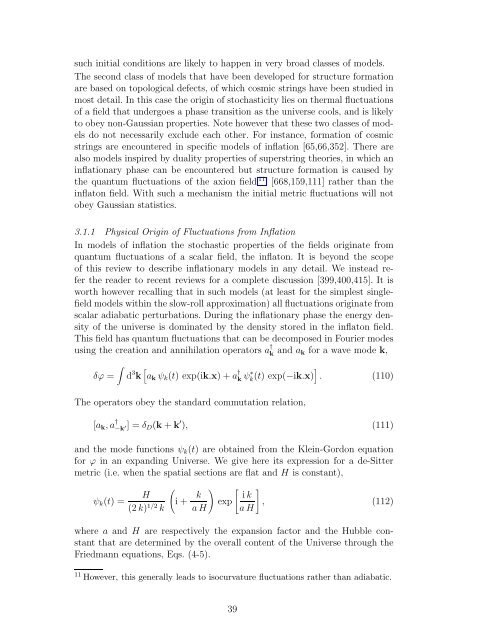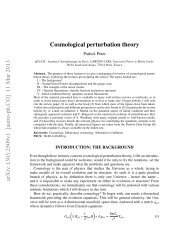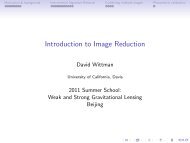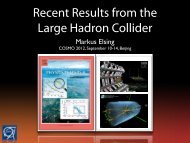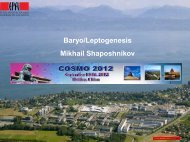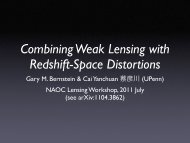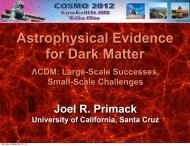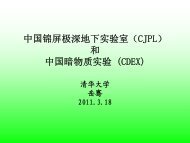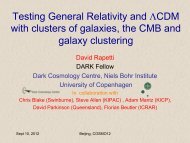Large-Scale Structure of the Universe and Cosmological ...
Large-Scale Structure of the Universe and Cosmological ...
Large-Scale Structure of the Universe and Cosmological ...
Create successful ePaper yourself
Turn your PDF publications into a flip-book with our unique Google optimized e-Paper software.
such initial conditions are likely to happen in very broad classes <strong>of</strong> models.<br />
The second class <strong>of</strong> models that have been developed for structure formation<br />
are based on topological defects, <strong>of</strong> which cosmic strings have been studied in<br />
most detail. In this case <strong>the</strong> origin <strong>of</strong> stochasticity lies on <strong>the</strong>rmal fluctuations<br />
<strong>of</strong> a field that undergoes a phase transition as <strong>the</strong> universe cools, <strong>and</strong> is likely<br />
to obey non-Gaussian properties. Note however that <strong>the</strong>se two classes <strong>of</strong> models<br />
do not necessarily exclude each o<strong>the</strong>r. For instance, formation <strong>of</strong> cosmic<br />
strings are encountered in specific models <strong>of</strong> inflation [65,66,352]. There are<br />
also models inspired by duality properties <strong>of</strong> superstring <strong>the</strong>ories, in which an<br />
inflationary phase can be encountered but structure formation is caused by<br />
<strong>the</strong> quantum fluctuations <strong>of</strong> <strong>the</strong> axion field 11 [668,159,111] ra<strong>the</strong>r than <strong>the</strong><br />
inflaton field. With such a mechanism <strong>the</strong> initial metric fluctuations will not<br />
obey Gaussian statistics.<br />
3.1.1 Physical Origin <strong>of</strong> Fluctuations from Inflation<br />
In models <strong>of</strong> inflation <strong>the</strong> stochastic properties <strong>of</strong> <strong>the</strong> fields originate from<br />
quantum fluctuations <strong>of</strong> a scalar field, <strong>the</strong> inflaton. It is beyond <strong>the</strong> scope<br />
<strong>of</strong> this review to describe inflationary models in any detail. We instead refer<br />
<strong>the</strong> reader to recent reviews for a complete discussion [399,400,415]. It is<br />
worth however recalling that in such models (at least for <strong>the</strong> simplest singlefield<br />
models within <strong>the</strong> slow-roll approximation) all fluctuations originate from<br />
scalar adiabatic perturbations. During <strong>the</strong> inflationary phase <strong>the</strong> energy density<br />
<strong>of</strong> <strong>the</strong> universe is dominated by <strong>the</strong> density stored in <strong>the</strong> inflaton field.<br />
This field has quantum fluctuations that can be decomposed in Fourier modes<br />
using <strong>the</strong> creation <strong>and</strong> annihilation operators a †<br />
k <strong>and</strong> ak for a wave mode k,<br />
<br />
δϕ =<br />
d 3 k <br />
ak ψk(t) exp(ik.x) + a †<br />
k ψ∗ k (t) exp(−ik.x) . (110)<br />
The operators obey <strong>the</strong> st<strong>and</strong>ard commutation relation,<br />
[ak, a †<br />
−k ′] = δD(k + k ′ ), (111)<br />
<strong>and</strong> <strong>the</strong> mode functions ψk(t) are obtained from <strong>the</strong> Klein-Gordon equation<br />
for ϕ in an exp<strong>and</strong>ing <strong>Universe</strong>. We give here its expression for a de-Sitter<br />
metric (i.e. when <strong>the</strong> spatial sections are flat <strong>and</strong> H is constant),<br />
ψk(t) =<br />
H<br />
(2 k) 1/2 k<br />
<br />
i + k<br />
<br />
exp<br />
a H<br />
<br />
i k<br />
, (112)<br />
a H<br />
where a <strong>and</strong> H are respectively <strong>the</strong> expansion factor <strong>and</strong> <strong>the</strong> Hubble constant<br />
that are determined by <strong>the</strong> overall content <strong>of</strong> <strong>the</strong> <strong>Universe</strong> through <strong>the</strong><br />
Friedmann equations, Eqs. (4-5).<br />
11 However, this generally leads to isocurvature fluctuations ra<strong>the</strong>r than adiabatic.<br />
39


